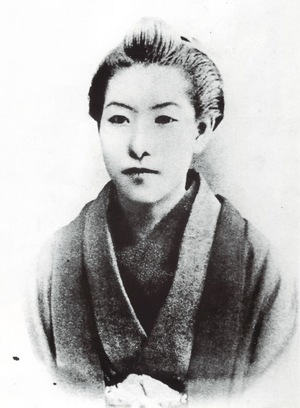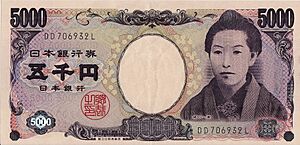Ichiyō Higuchi facts for kids
Quick facts for kids
Ichiyō Higuchi
|
|
|---|---|
 |
|
| Native name |
樋口 一葉
|
| Born | Natsuko Higuchi May 2, 1872 Uchisaiwaichō, Tokyo, Japan |
| Died | November 23, 1896 (aged 24) Tokyo, Japan |
| Resting place | Yanaka Cemetery, Tokyo, Japan |
| Pen name | Ichiyō Higuchi |
| Occupation | writer |
| Nationality | Japanese |
| Period | Meiji |
| Genre | fiction |
Natsu Higuchi (born May 2, 1872 – died November 23, 1896), known by her pen name Ichiyō Higuchi, was a famous Japanese writer. She lived during the Meiji period (1868–1912).
Higuchi was special because her writing style was based on traditional Japanese ways. Other writers at the time often copied Western styles. She came from a family that used to be samurai. Her family faced poverty, especially after her father died in 1889. She became the head of her household, which was unusual for a woman then.
Her experiences with hardship greatly influenced her stories. She wrote about feelings of being left alone and suffering, but with a lot of care and understanding. She mostly wrote short stories. Higuchi was one of the first important writers of the Meiji period. She was also Japan's first well-known woman writer in modern times.
She kept a detailed diary for many years. Even though she died young at 24, her stories have had a big impact on Japanese literature.
Contents
Early Life and Education
Natsuko Higuchi was born in Chiyoda-ku, Tokyo, on May 2, 1872. She was the youngest daughter of Noriyoshi Higuchi. Her father was a samurai from Yamanashi Prefecture. Even though her parents were from a farming background, her father became a samurai in 1867. This samurai status was important for her family, even though it didn't last long after the Meiji Restoration.
Studying Poetry
In 1886, Higuchi started studying waka poetry at a famous school called the Haginoya. She became a student of Nakajima Utako. At this school, she had weekly poetry lessons and learned about Japanese literature. There were also monthly poetry contests.
Higuchi often felt out of place among the other students. Most of them came from rich families. She was also shy, small, and nearsighted, which made her feel even more awkward.
Keeping a Diary
By 1891, Higuchi started writing in her diary very seriously. This diary grew to hundreds of pages and covered the last five years of her life. Because she felt socially inferior and her family was getting poorer, her diary became a place where she could truly express herself.
Her journals also showed her thoughts on writing and what others thought of her work. It was a private space where she could be honest.
Becoming a Writer
In 1889, Higuchi's father passed away. She was then named the head of her family, which was not common for women at that time. Her family had very little money. She, her mother, and her younger sister worked hard doing needlework and washing clothes to earn money.
In 1892, Higuchi decided to become a novelist. She was inspired by a classmate, Kaho Tanabe, who had written a successful novel. Higuchi hoped writing could help her support her family.
First Steps in Fiction
Her first attempts at writing were short stories. In 1891, she met Tosui Nakarai, who became her advisor. She hoped he would help her, a poet, become a fiction writer and connect her with publishers. He treated her like a younger sister. This relationship later influenced themes in her stories.
Finally, her first stories were published in a small newspaper. She used her pen name, Ichiyo Higuchi. These early stories (from 1892–1894) showed a strong influence from old Heian poetry. She wanted to show off her classical training. The plots were simple, characters were not very developed, and there was a lot of emotion. However, she was learning quickly.
Some of her common themes started to appear in these stories. For example, she often wrote about a lonely, beautiful young woman who had lost her parents. Another theme was the ambition and sometimes harshness of the middle class during the Meiji period.
Her story "Umoregi" (meaning "In Obscurity") showed that she was becoming a serious writer. It was published in a respected magazine called Miyako no Hana in 1892. This was only nine months after she started writing seriously. People noticed her work, and she was seen as a promising new author.
Later Life and Fame
In 1893, Higuchi, her mother, and her sister moved to a poor neighborhood. They were determined to survive and opened a stationery store, but it soon failed. Living in this neighborhood gave her ideas for many of her later stories. One famous example is "Takekurabe" (meaning "Comparing heights" or "Child's Play").
Mature Works
Her stories from her later period (1894–1896) were influenced by Ihara Saikaku, a writer from the 1600s. She had recently discovered his works. Saikaku was special because he wrote about everyday people and their lives. Higuchi added her own deep understanding of suffering and feelings to her stories.
Some of her best works from this time include "Ōtsugomori" ("On the Last Day of the Year"), "Nigorie" ("Troubled Waters"), "Wakare-Michi" ("Separate Ways"), "Jūsan'ya" ("The Thirteenth Night"), and "Takekurabe" ("Child's Play"). The last two are thought to be her finest stories.
Growing Recognition and Final Days
With these later stories, Higuchi became very famous in Tokyo's literary world. People praised her traditional writing style. She was even called "the last woman of the old Meiji" because her writing reminded people of the past.
Many writers, students, fans, critics, and editors visited her modest home. They wanted to work with her or just meet her. However, constant interruptions and frequent headaches made it hard for her to write. Like her father and one of her brothers, she got tuberculosis. She died on November 23, 1896, at the age of 24.
Higuchi's picture is on the Japanese 5000 yen banknote since 2004. She was the third woman to appear on a Japanese banknote. Some of her most famous stories have also been made into movies. She is buried in Tsukiji Hongan-ji Wadabori Cemetery in Suginami, Tokyo.
Selected Works
The year next to each title is when it was first published.
- 1892: Yamizakura (闇桜, Flowers at Dusk)
- 1892: Wakarejimo (別れ霜)
- 1892: Tamadasuki (玉襷)
- 1892: Samidare (五月雨)
- 1892: Kyōtsukue (経づくえ)
- 1892: Umoregi (うもれ木)
- 1893: Aketsukiyo (暁月夜)
- 1893: Yuki no hi (雪の日, A Snowy Day)
- 1893: Koto no ne (琴の音, The Sound of the Koto)
- 1894: Hanagomorie (花ごもり)
- 1894: Yamiyo (やみ夜, Encounters on a Dark Night)
- 1894: Ōtsugomori (大つごもり, On the Last Day of the Year or The Last Day of the Year)
- 1895: Takekurabe (たけくらべ, Child's Play, Growing Up, They Compare Heights or Teenagers Vying for Tops)
- 1895: Noki moru tsuki (軒もる月)
- 1895: Yukugumo (ゆく雲)
- 1895: Utsusemi (うつせみ)
- 1895: Nigorie (にごりえ, Troubled Waters, Muddy Water or In the Gutter)
- 1895: Jūsan'ya (十三夜, The Thirteenth Night)
- 1896: Kono ko (この子)
- 1896: Wakare-michi (わかれ道, Separate Ways or The Parting of the Ways)
- 1896: Ware-kara (われから)
See also
 In Spanish: Ichiyō Higuchi para niños
In Spanish: Ichiyō Higuchi para niños



